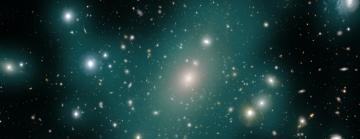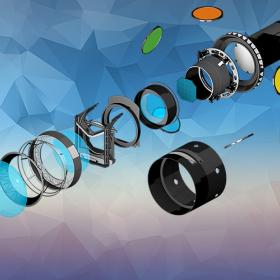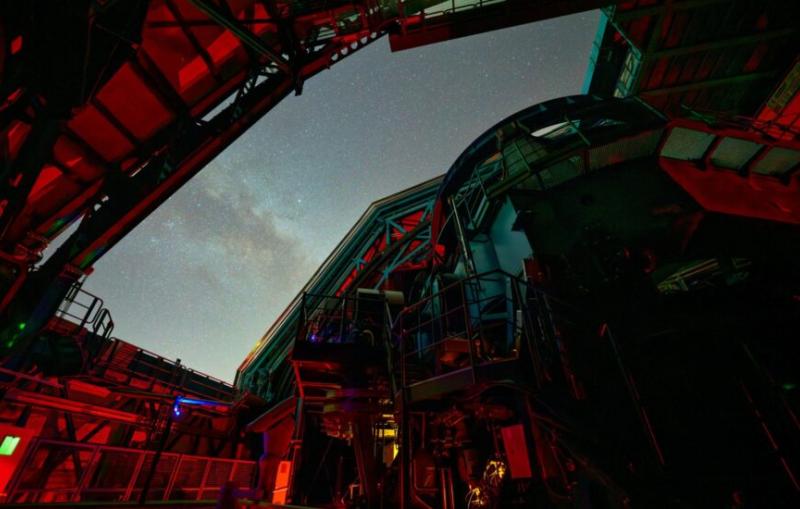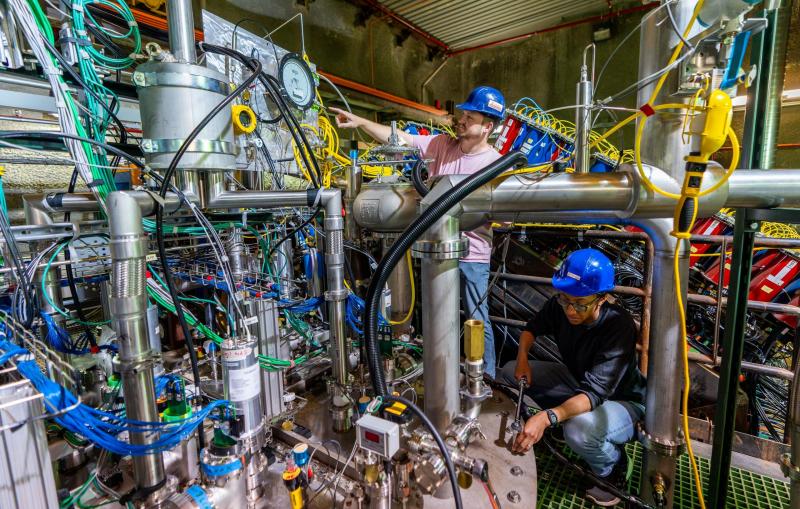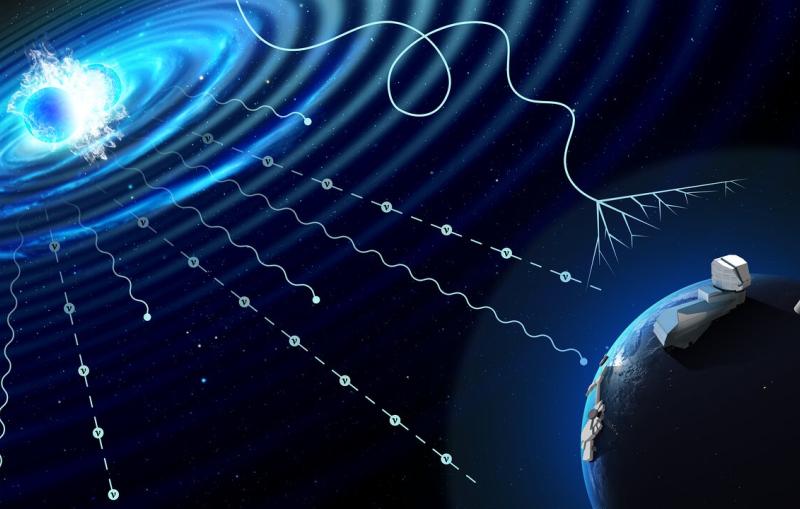Rubin Observatory will unlock fossil record of galaxy cluster evolution
Vera C. Rubin Observatory’s fast-moving telescope and huge digital camera will illuminate the faint glow of free-floating stars within galaxy clusters, providing unprecedented insight into the evolution of these dynamic structures.
LSST Camera
Vera C. Rubin Observatory will search wide and deep into the cosmos for signs of dark matter and dark energy and yield new insights into our own galaxy and solar system. SLAC built Rubin's LSST Camera (above), the largest camera ever built for astrophysics. SLAC will also host Rubin's U.S. Data Facility and co-lead the observatory's operations along with NSF's NOIRLab. (Image Credit: Jacqueline Ramseyer Orrell/SLAC National Accelerator Laboratory)
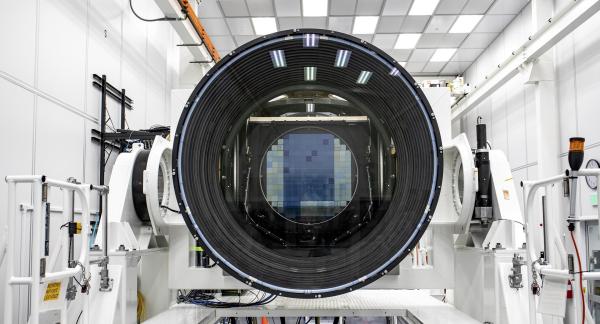
Intracluster light, the collective glow of innumerable stars stripped from their home galaxies and left to wander vast intergalactic space, is incredibly faint and difficult to detect. Vera C. Rubin Observatory’s upcoming Legacy Survey of Space and Time will be the first astronomical survey to provide scientists with the data they need to detect intracluster light in thousands of galaxy clusters, unlocking clues to the evolutionary history of the Universe on large scales.
Galaxies, like our Milky Way galaxy, are collections of billions of stars held together by gravity. Sometimes galaxies clump together in clusters containing hundreds or even thousands of galaxies. These galaxy clusters are the largest objects in the Universe that are held together by their own gravity, and they take billions of years to form and change. If we could somehow watch their evolution in fast-forward, we wouldn’t need movies — the dramatic interactions between galaxies would keep us mesmerized. But there is a way we can read the stories of galaxy cluster history, and our cosmic storyteller is the population of stars that have been stripped from their home galaxies and strewn into the spaces between galaxies in the cluster. These stars give off a ghostly glow called intracluster light, and it’s at least 1000 times fainter than the darkest night sky we can perceive with our eyes. Intracluster light has stayed mostly hidden from existing telescopes and cameras because it’s so faint. But with the data from Vera C. Rubin Observatory’s Legacy Survey of Space and Time, which will begin in 2025, scientists will be able to observe this extremely faint light like never before.
Rubin Observatory is jointly funded by the U.S. National Science Foundation (NSF) and the US Department of Energy (DOE). Rubin is a Program of NSF’s NOIRLab, and SLAC National Accelerator Laboratory, which will jointly operate Rubin.
Over millions of years, as galaxies collide and merge, intracluster light forms a ‘fossil record’ of the dynamical interactions a galaxy cluster has experienced, offering a wealth of information about the history of the cluster system and the history of the Universe on large scales.
“Stars stripped from their galaxies end up populating the space between galaxies in a cluster. These stars are like the dust released from a piece of chalk when you write on a blackboard,” said Mireia Montes, research fellow at Instituto de Astrofísica de Canarias and member of the Rubin/LSST Galaxies Science Collaboration. "By tracking the stellar chalk dust with Rubin, we hope to be able to read the words on the galaxy cluster blackboard."
How many of a galaxy cluster’s stars are actually free-floating, contributing to the glow? How are they distributed in the cluster? The answers to these questions aren’t well known, because intracluster light has been so difficult to study until now. “There’s so much we don’t know about intracluster light,” said Montes. “The power of Rubin is that it’s going to provide us with lots of clusters of galaxies that we can explore.”
In addition to studying intracluster light for clues about the history of galaxy clusters, scientists can also use it to gain insight about the elusive substance known as dark matter — an invisible material that doesn’t emit or reflect light and is found in high concentrations around clusters of galaxies.
Rubin will scan the entire southern hemisphere sky every few nights for ten years with the largest digital camera in the world, revealing intracluster light that, until now, astronomers have largely been able to detect only with long and targeted observations of one galaxy cluster at a time. Over the course of its 10-year survey, Rubin will take millions of high-resolution images of distant galaxy clusters, and scientists will be able to stack these images together into the largest ultra-long-exposure images ever created of the southern hemisphere sky. The stacked images will give scientists more galaxy clusters with detectable intracluster light in each field of view than they've had in total to date. In this way, Rubin will expand the number of galaxy clusters we can study from just a handful to thousands, which will allow researchers like Montes to analyze the faint glow of intracluster light across the Universe.
From the evolution of galaxy clusters to the distribution of dark matter, intracluster light holds important clues about how the large-scale structure of the Universe came to be. “Intracluster light may look like something very small and insignificant, but it has a lot of implications,” Montes said. “It complements what we already know, and will open new windows into the history of our Universe.”
Rubin Observatory is a joint initiative of the US National Science Foundation (NSF) and the Department of Energy (DOE). Its primary mission is to carry out the Legacy Survey of Space and Time, providing an unprecedented data set for scientific research supported by both agencies. Rubin is operated jointly by NSF’s NOIRLab and SLAC National Accelerator Laboratory (SLAC). NOIRLab is managed for NSF by the Association of Universities for Research in Astronomy (AURA) and SLAC is operated for DOE by Stanford University. Additional contributions from a number of international organizations and teams are acknowledged.
This article is based on a release from Rubin Observatory.
For questions or comments, contact the SLAC Office of Communications at communications@slac.stanford.edu.
About SLAC
SLAC National Accelerator Laboratory explores how the universe works at the biggest, smallest and fastest scales and invents powerful tools used by researchers around the globe. As world leaders in ultrafast science and bold explorers of the physics of the universe, we forge new ground in understanding our origins and building a healthier and more sustainable future. Our discovery and innovation help develop new materials and chemical processes and open unprecedented views of the cosmos and life’s most delicate machinery. Building on more than 60 years of visionary research, we help shape the future by advancing areas such as quantum technology, scientific computing and the development of next-generation accelerators.
SLAC is operated by Stanford University for the U.S. Department of Energy’s Office of Science. The Office of Science is the single largest supporter of basic research in the physical sciences in the United States and is working to address some of the most pressing challenges of our time.
